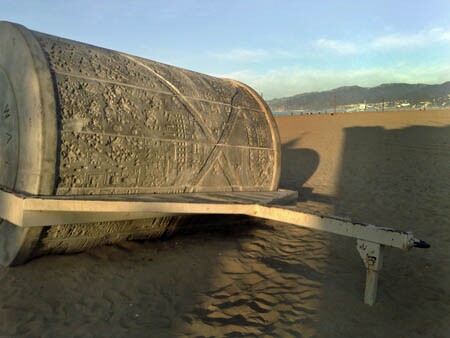The 88 considered as a game of Go

There are 88 cities in Los Angeles County. The oldest is Los Angeles itself, becoming an American-style municipal corporation on April 4, 1850. The newest cities in Los Angeles County are preparing this week to celebrate 20 years of cityhood. Malibu and Calabasas incorporated in mid-1991.There might have been more than the today's 88 cities. The City of San Pedro had been an important commercial hub for 21 years before it was absorbed into Los Angeles in 1909. Venice held off as long, having been incorporated in 1904 and disincorporated into Los Angeles in 1925.
The cities of Hollywood, Wilmington, Sawtelle, Watts, Eagle Rock, Hyde Park, Tujunga, and Barnes City each had their own civic identity - fragile, it now seems - until each was annexed to Los Angeles between 1910 and 1927. Belmont Heights fell to Long Beach in 1909. Tropico was taken by Glendale in 1918.
Vernon may be the next city to evaporate through what amounts to a hostile takeover. (The backstory is here and here.)
In a bit of appropriate irony, the city that is home to pork processing plants is about to be led to the legislative abattoir by Assembly Speaker John Pérez. If he gets his way, the former City of Vernon will emerge rendered and packaged for the tax hungry City of Los Angeles.
If turn-of-the 20th-century Progressives had been successful, Los Angeles would have finished off all its neighbors to become one, big city. The boom years of 1886-1888 had led to a clutch of incorporations that consisted mainly of a plat map, some scattered houses, and a grand and empty hotel. The spectacle of the county's many "phantom cities" prompted calls for the creation of a joint City and County of Los Angeles to put the entire county into a single municipality.
A wave of defensive incorporations followed. Between 1900 and 1930, 32 cities in Los Angeles County incorporated, most of them in the looming shadow of Los Angeles and its aggressive campaign of annexations. They became cities in part because they didn't want to become an appendage of their bigger neighbor and its deeply corrupt political machine. (And because, unlike the cities Los Angeles swallowed up, the independent cities had access to water not tied to the Owens Valley aqueduct.)
In one of the oldest clichés of Los Angeles (which still has a bit of truth), mere chaos created the 88 cities. It would be more accurate to compare them to pieces in a century-long game of Go (where the object is to control as much contiguous territory as possible while frustrating your opponent's attempts to do the same.)
Nostalgists for one, big government in Los Angeles have returned to municipal consolidation in recent years. Former Assembly Speakers Willie Brown and Bob Hertzberg advocated a regional "super-government" for Southern California and municipal consolidation for Los Angeles County. Some of these plans took Australia and New Zealand as models, where city governments were forced to "amalgamate" by their central government in the 1980s and 1990s.
Throughout the 20th century, the small and medium-size cities of Los Angeles County chose - for better or worse - to manage the future as best they could by avoiding the juggernaut of Los Angeles. They came up with new models for providing city services, including regional consortiums, joint-powers authorities, city-to-city contracting, and contracting with county agencies.
Some of these cities turned out like Claremont and Beverly Hills and Burbank. And some of them became cities like Bell and Vernon.
The 88 cities of the county - perhaps soon to be 87 - are neither particularly good nor particularly bad at doing what cities are supposed to do. They are simply the places some people call home.
D. J. Waldie, author, historian, and as the New York Times said in 2007, "a gorgeous distiller of architectural and social history," writes about Los Angeles every Monday and Friday at 2 p.m. on KCET's SoCal Focus blog.
The image on this page of a roller that impresses a 3D image of Los Angeles in beach sand was taken by flickr user emilymcmc. It is used under a Creative Commons License.


